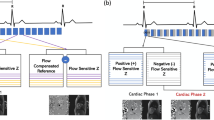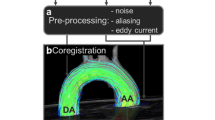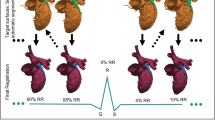Abstract
Objectives
Assessment of haemodynamics is crucial in many cardiac diseases. Phase contrast MRI (PC-MRI) can accurately access it. Arrhythmia is a major limitation in conventional segmented PC-MRI (SEG). A real-time PC-MRI sequence (RT) could overcome this. We validated RT by comparing to SEG.
Methods
A prototype RT using shared velocity encoding was tested against SEG at 1.5 T in a flow phantom and consecutively included patients with (n = 55) or without (n = 59) aortic valve disease. In patients with atrial fibrillation (Afib, n = 15), only RT was applied.
Phantom: PC images were acquired in front of and behind an interchangeable aortic-stenosis-like inlay. Mean velocity and flow were quantified.
Patients: PC images were acquired in the ascending aorta, pulmonary trunk and superior caval vein. Peak velocity, stroke volume and regurgitant fraction were quantified.
Results
Phantom: Mean velocities (11 ± 1 to 207 ± 10 cm/s) and flow correlated closely between SEG and RT (r ≥ 0.99, ICC ≥ 0.98, p < 0.0005).
Patients without AVD or with aortic regurgitation: Concordance of SEG and RT was excellent regarding peak velocities, stroke volumes (r ≥ 0.91, ICC ≥ 0.94, p < 0.0005) and regurgitant fractions (r = 0.95, ICC = 0.95, p < 0.0005).
RT was feasible in all patients with Afib.
Conclusions
The real-time sequence is accurate compared to conventional segmented PC-MRI. Its applicability in Afib was shown. Real-time PC-MRI might become a valuable tool in arrhythmia.
Key Points
• Assessment of haemodynamics is crucial in many cardiac diseases.
• Arrhythmias are a major limitation of conventional techniques in cardiac magnetic resonance.
• A real-time technique, which allows application in arrhythmia, was validated.
• This real-time technique might become a valuable tool in arrhythmic patients.








Similar content being viewed by others
Abbreviations
- Afib:
-
Atrial fibrillation
- Ao asc:
-
Ascending aorta
- AR:
-
Aortic valve regurgitation
- AS:
-
Aortic valve stenosis
- AVD:
-
Aortic valve disease
- CMR:
-
Cardiovascular magnetic resonance
- EPI:
-
Echo planar imaging
- MPA:
-
Main pulmonary artery
- PC-MRI:
-
Phase contrast magnetic resonance imaging
- RF:
-
Regurgitant fraction
- RT:
-
Real-time PC-MRI
- SCV:
-
Superior caval vein
- SEG:
-
Conventional gradient-echo PC-MRI
- VOA:
-
Valve orifice area
References
Vahanian A, Alfieri O, Andreotti F et al (2012) Guidelines on the management of valvular heart disease (version 2012). Eur Heart J 33:2451–2496
Baumgartner H, Bonhoeffer P, De Groot NM et al (2010) ESC Guidelines for the management of grown-up congenital heart disease (new version 2010). Eur Heart J 31:2915–2957
Nishimura RA, Otto CM, Bonow RO et al (2014) 2014 AHA/ACC guideline for the management of patients with valvular heart disease: a report of the American College of Cardiology/American Heart Association Task Force on Practice Guidelines. J Am Coll Cardiol 63:e57–e185
Hundley WG, Li HF, Hillis LD et al (1995) Quantitation of cardiac output with velocity-encoded, phase-difference magnetic resonance imaging. Am J Cardiol 75:1250–1255
Van Rossum AC, Sprenger M, Visser FC, Peels KH, Valk J, Roos JP (1991) An in vivo validation of quantitative blood flow imaging in arteries and veins using magnetic resonance phase-shift techniques. Eur Heart J 12:117–126
Debatin JF, Leung DA, Wildermuth S, Botnar R, Felblinger J, McKinnon GC (1995) Flow quantitation with echo-planar phase-contrast velocity mapping: in vitro and in vivo evaluation. J Magn Reson Imaging 5:656–662
Ley S, Unterhinninghofen R, Ley-Zaporozhan J, Schenk JP, Kauczor HU, Szabo G (2008) Validation of magnetic resonance phase-contrast flow measurements in the main pulmonary artery and aorta using perivascular ultrasound in a large animal model. Investig Radiol 43:421–426
Powell AJ, Tsai-Goodman B, Prakash A, Greil GF, Geva T (2003) Comparison between phase-velocity cine magnetic resonance imaging and invasive oximetry for quantification of atrial shunts. Am J Cardiol 91:A1529
Gelfand EV, Hughes S, Hauser TH et al (2006) Severity of mitral and aortic regurgitation as assessed by cardiovascular magnetic resonance: optimizing correlation with Doppler echocardiography. J Cardiovasc Magn Reson 8:503–507
Cawley PJ, Hamilton-Craig C, Owens DS et al (2013) Prospective comparison of valve regurgitation quantitation by cardiac magnetic resonance imaging and transthoracic echocardiography. Circ Cardiovasc Imaging 6:48–57
Pennell DJ, Sechtem UP, Higgins CB et al (2004) Clinical indications for cardiovascular magnetic resonance (CMR): consensus panel report. J Cardiovasc Magn Reson 6:727–765
Baltes C, Hansen MS, Tsao J et al (2008) Determination of peak velocity in stenotic areas: echocardiography versus k-t SENSE accelerated MR Fourier velocity encoding. Radiology 246:249–257
Lee VS, Spritzer CE, Carroll BA et al (1997) Flow quantification using fast cine phase-contrast MR imaging, conventional cine phase-contrast MR imaging, and Doppler sonography: in vitro and in vivo validation. AJR Am J Roentgenol 169:1125–1131
Srichai MB, Lim RP, Wong S, Lee VS (2009) Cardiovascular applications of phase-contrast MRI. AJR Am J Roentgenol 192:662–675
Hendel RC, Patel MR, Kramer CM et al (2006) ACCF/ACR/SCCT/SCMR/ASNC/NASCI/SCAI/SIR 2006 appropriateness criteria for cardiac computed tomography and cardiac magnetic resonance imaging: a report of the American College of Cardiology Foundation Quality Strategic Directions Committee Appropriateness Criteria Working Group, American College of Radiology, Society of Cardiovascular Computed Tomography, Society for Cardiovascular Magnetic Resonance, American Society of Nuclear Cardiology, North American Society for Cardiac Imaging, Society for Cardiovascular Angiography and Interventions, and Society of Interventional Radiology. J Am Coll Cardiol 48:1475–1497
O’Brien KR, Cowan BR, Jain M, Stewart RA, Kerr AJ, Young AA (2008) MRI phase contrast velocity and flow errors in turbulent stenotic jets. J Magn Reson Imaging 28:210–218
Schnabel RB, Sullivan LM, Levy D et al (2009) Development of a risk score for atrial fibrillation (Framingham Heart Study): a community-based cohort study. Lancet 373:739–745
Gatehouse PD, Keegan J, Crowe LA et al (2005) Applications of phase-contrast flow and velocity imaging in cardiovascular MRI. Eur Radiol 15:2172–2184
Mohiaddin RH, Gatehousee D, Moon JC et al (2002) Assessment of reactive hyperaemia using real time zonal echo-planar flow imaging. J Cardiovasc Magn Reson 4:283–287
Wintersperger BJ, Nikolaou K, Dietrich O et al (2003) Single breath-hold real-time cine MR imaging: improved temporal resolution using generalized autocalibrating partially parallel acquisition (GRAPPA) algorithm. Eur Radiol 13:1931–1936
Steeden JA, Atkinson D, Taylor AM, Muthurangu V (2010) Split-acquisition real-time CINE phase-contrast MR flow measurements. Magn Reson Med 64:1664–1670
Lin HY, Bender JA, Ding Y et al (2012) Shared velocity encoding: a method to improve the temporal resolution of phase-contrast velocity measurements. Magn Reson Med 68:703–710
von Knobelsdorff-Brenkenhoff F, Dieringer MA, Greiser A, Schulz-Menger J (2011) In vitro assessment of heart valve bioprostheses by cardiovascular magnetic resonance: four-dimensional mapping of flow patterns and orifice area planimetry. Eur J Cardiothorac Surg 40:736–742
Myerson SG (2012) Heart valve disease: investigation by cardiovascular magnetic resonance. J Cardiovasc Magn Reson 14:7
Devos DG, Kilner PJ (2010) Calculations of cardiovascular shunts and regurgitation using magnetic resonance ventricular volume and aortic and pulmonary flow measurements. Eur Radiol 20:410–421
Toska K, Eriksen M (1993) Respiration-synchronous fluctuations in stroke volume, heart rate and arterial pressure in humans. J Physiol 472:501–512
Kunichika N, Miyahara N, Harada M, Tanimoto M (2002) Respiratory variation in superior vena cava flow in patients with chronic obstructive pulmonary disease: estimation of pulmonary hypertension using Doppler flow index. J Am Soc Echocardiogr 15:1165–1169
Myerson SG, d’Arcy J, Mohiaddin R et al (2012) Aortic regurgitation quantification using cardiovascular magnetic resonance: association with clinical outcome. Circulation 126:1452–1460
Lancellotti P, Tribouilloy C, Hagendorff A et al (2010) European Association of Echocardiography recommendations for the assessment of valvular regurgitation. Part 1: aortic and pulmonary regurgitation (native valve disease). Eur J Echocardiogr 11:223–244
Gosselink AT, Blanksma PK, Crijns HJ et al (1995) Left ventricular beat-to-beat performance in atrial fibrillation: contribution of Frank-Starling mechanism after short rather than long RR intervals. J Am Coll Cardiol 26:1516–1521
Clark DM, Plumb VJ, Epstein AE, Kay GN (1997) Hemodynamic effects of an irregular sequence of ventricular cycle lengths during atrial fibrillation. J Am Coll Cardiol 30:1039–1045
Thavendiranathan P, Verhaert D, Walls MC et al (2012) Simultaneous right and left heart real-time, free-breathing CMR flow quantification identifies constrictive physiology. JACC Cardiovasc Imaging 5:15–24
Nezafat R, Kellman P, Derbyshire JA, McVeigh ER (2005) Real-time blood flow imaging using autocalibrated spiral sensitivity encoding. Magn Reson Med 54:1557–1561
Joseph A, Kowallick JT, Merboldt KD et al (2013) Real-time flow MRI of the aorta at a resolution of 40 msec. J Magn Reson Imaging. doi:10.1002/jmri.24328
Joseph AA, Merboldt KD, Voit D et al (2012) Real-time phase-contrast MRI of cardiovascular blood flow using undersampled radial fast low-angle shot and nonlinear inverse reconstruction. NMR Biomed 25:917–924
Tsao J, Kozerke S (2012) MRI temporal acceleration techniques. J Magn Reson Imaging 36:543–560
Acknowledgements
We thank Philipp Barckow from Circle Cardiovascular Imaging Inc., Calgary, Canada for adapting cvi42 post-processing software to our purposes as well as our technicians for their assistance in acquiring the images; furthermore, Dr. Fabian Mühlberg and Dr. Simone Fritschi for carefully reviewing the manuscript. The scientific guarantor of this publication is Jeanette Schulz-Menger. The authors of this manuscript declare relationships with the following companies: Matthias Dieringer and Andreas Greiser are employees of Siemens AG Healthcare Sector, Erlangen, Germany. Ning Jin is an employee of Siemens Medical Solutions USA, Inc., Columbus, USA. The other authors of this manuscript declare no relationships with any companies whose products or services may be related to the subject matter of the article. The authors state that this work has not received any funding. No complex statistical methods were necessary for this paper. Institutional review board approval was obtained. Written informed consent was obtained from all subjects (patients) in this study. Methodology: prospective, experimental, performed at one institution.
Author information
Authors and Affiliations
Corresponding author
Rights and permissions
About this article
Cite this article
Traber, J., Wurche, L., Dieringer, M.A. et al. Real-time phase contrast magnetic resonance imaging for assessment of haemodynamics: from phantom to patients. Eur Radiol 26, 986–996 (2016). https://doi.org/10.1007/s00330-015-3897-7
Received:
Revised:
Accepted:
Published:
Issue Date:
DOI: https://doi.org/10.1007/s00330-015-3897-7




